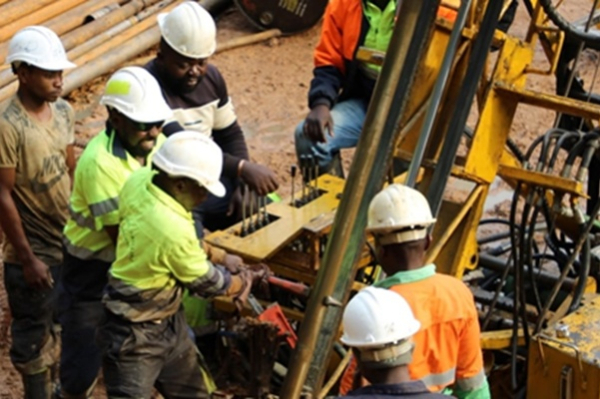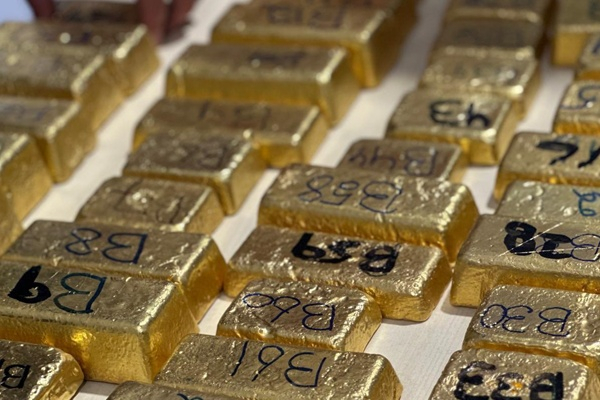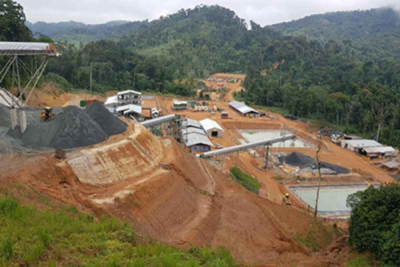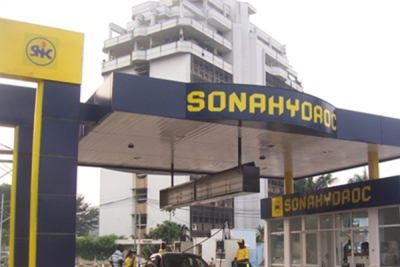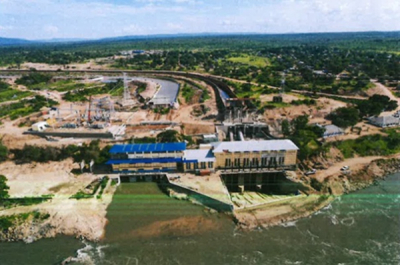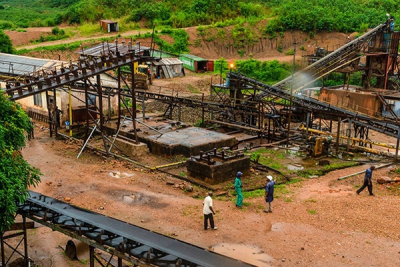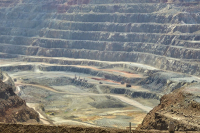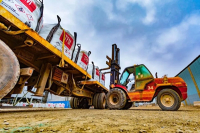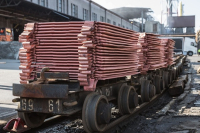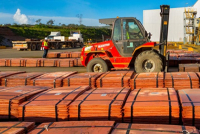
MINING (162)
On April 24, 2025, Rome Resources announced plans to resume drilling at its Bisie North tin project in eastern DRC, after suspending activities on March 14 due to security concerns.
The company aims to begin drilling within 10 days, targeting high-grade tin deposits at depth. This phase is budgeted at $1.6 million, funded from Rome’s $2.7 million cash reserves.
The decision follows the M23 rebel group’s withdrawal from the region and Alphamin Resources’ April 9 announcement to gradually restart production at the nearby Bisie mine, which had also paused in March.
#RMR Drilling Restart at Bisie North
— Rome_Resources (@Rome_Resources) April 24, 2025
🔹Mobilisation to site by 1 May, drilling to resume thereafter
🔹M23 rebel withdrawal enables operations restart across region
🎯Fully funded programme targets higher-grade #Tin at depth
🔹Results from MADD024/026 expected within 2 weeks
Located about 280 km west of Goma near the key mining hub of Walikale-centre, the Bisie site saw rebel occupation between March 19 and April 3 before the Congolese army reclaimed control. Rebels reportedly retreated over 130 km east to Nyabiondo and Masisi.
Political progress adds to optimism: on April 23, the government and M23 declared their intent to agree on a truce, while on April 25, the DRC and Rwanda signed a “declaration of principles” in Washington, signaling a step toward peace.
Rome Resources expects to publish initial resource estimates for its Mont Agoma and Kalayi prospects by the end of May 2025. The market eagerly awaits these results.
This article was initially in French by Pierre Mukoko (Ecofin Agency)
Edited in English by Ola Schad Akinocho
Gold prices could soar past $4,000 per ounce in 2026, according to a JP Morgan note published April 22, 2025. The American bank attributes its bullish forecast to rising recession risks in the US and ongoing trade tensions between Washington and Beijing.
JP Morgan expects gold to average $3,675/oz by Q4 2025, climbing above $4,000 in the second quarter of 2026. The bank warns prices could break these thresholds even sooner if demand outpaces expectations.
While global prices are set to surge, gold production in the DRC is heading the other way. In 2024, the Kibali mine—DRC’s main industrial gold site—produced 686,000 ounces, down 10% from 763,000 ounces in 2023, marking its lowest output since 2019, when production hit 813,000 ounces.
The artisanal sector is faring even worse: official gold exports plunged 66% in 2024, from 5.18 tonnes to just 1.75 tonnes. The outlook for 2025 remains bleak, with state-owned DRC Gold Trading SA struggling to operate amid persistent security tensions in the east, fueling smuggling and choking off legal exports.
Demand Up
If gold production in the DRC keeps falling, the country could miss out on the price surge. Being one of the world’s major producers, if its output keeps lowering, prices could remain high.
JP Morgan highlights strong demand from investors and central banks, expected to average 710 tonnes per quarter this year..
On April 22, 2025, gold’s spot price broke $3,500 per ounce for the first time, driven by US-China trade tensions and friction between President Trump and the Federal Reserve. Trump’s pressure to cut interest rates is fueling gold’s rise.
Historically, gold prices move in the opposite direction to interest rates. When rates fall, bonds lose appeal and gold’s safe-haven status strengthens, especially amid geopolitical uncertainty.
The dollar’s fall against the euro, hitting a three-year low, further boosts gold’s appeal as a protective asset.
In early April, Goldman Sachs raised its forecast to $3,700 per ounce by end-2025, up from $3,300, and even suggested gold could reach $4,500 in extreme cases.
This article was initially published in French by Pierre Mukoko (Ecofin Agency)
Edited in English by Ola Schad Akinocho
This year, Alphamin Resources anticipates an output of 17,500 tons at its Bisie tin mine in the Democratic Republic of Congo (DRC). The figure is down 14.2% compared to the previous forecast of 20,000 tons. The firm issued the revised target in a statement dated April 17.
In the official statement, Alphamin attributed its decision to a “security-related interruption.”
Operations were temporarily halted on March 13 due to the advancing M23 rebel group and their Rwandan allies, raising safety concerns for employees and subcontractors. Production subsequently plummeted by 18.4% in Q1 2025 compared to Q4 2024, dropping from 5,237 to 4,270 tonnes.
Despite the rebels’ proximity, Alphamin resumed processing stockpiled ore on April 15. Mining activities are set to gradually restart this month, with staff and logistics providers—including those handling equipment and tin transport—returning to the site.
However, reaching the revised production goal depends heavily on the security situation. Peace talks between the Congolese government and M23 rebels began in Doha under Qatar’s mediation, but no major progress has yet been reported.
This article was initially published in French by Pierre Mukoko
Edited in English by Ola Schad Akinocho
At its April 11 Council of Ministers meeting, the Democratic Republic of Congo (DRC) adopted a draft decree granting petroleum rights directly to the state-owned Société Nationale des Hydrocarbures du Congo (Sonahydroc). The decree outlines the legal and fiscal framework for this transfer, in line with the 1 August 2015 oil and gas law.
This move is part of the DRC’s renewed strategy to revive exploration and ramp up oil production, aiming to better harness its resource potential. The plan includes “immediately” awarding Sonahydroc petroleum rights for blocks 1 and 2 in the Albertine Graben through service contracts.
Service contracts offer more attractive tax terms than production sharing agreements and avoid signing bonuses, making them a favored tool to attract foreign investors. Once awarded, Sonahydroc will develop these blocks in partnership with local and international companies.
Since July 2022, the DRC has sought partners to exploit 27 oil blocks. After canceling a tender in October 2024, the oil and gas Minister announced a relaunch for early 2025, prioritizing “restricted tenders for strategic blocks.”
However, this direct allocation to Sonahydroc marks a shift toward greater state control, echoing Prime Minister Judith Suminwa’s call for tighter organization of block distribution and a stronger role for the government in the oil sector.
Estimates of DRC’s reserves vary wildly: the presidency cites 22 billion barrels across 27 blocks; other sources suggest around 5 billion barrels; while the CIA World Factbook lists proven reserves at just 180 million barrels.
This article was initially published in French by Ronsard Luabeya (intern)
Edited in English by Ola Schad Akinocho
On April 14, 2025, Katamba Mining, 70% owned by China’s Zijin Mining, launched a tender to hire a subcontractor to build and operate a crushing plant. The facility will produce gravel and sand for the Mpiana-Mwanga III hydroelectric project, located over 90 km northeast of Manono in Tanganyika province. Interested companies have until April 22 to submit bids.
The hired company will set up temporary infrastructure, build a production system, mobilize equipment and personnel, site logistics, transport materials, ensure waste disposal, produce technical reports, and carry out maintenance works.
This project follows the recent rehabilitation of the first two phases of the nearly century-old plant, idle since 1998. Katamba Mining invested $80 million to restore the facility and boost its capacity by 30%, raising it to 40 MW as announced in December 2024. However, during a March 2025 site visit, MP John Banza Lunda noted that only the first unit is operational, delivering 4 MW.
Details remain sparse, but last January, Katamba’s second-largest shareholder, Congolaise d’Exploitation Minière (Cominière), estimated the new plant’s capacity at around 150 MW, with the entire complex eventually nearing 200 MW.
Powering Manono Mine
According to the recently launched tender, work on the crushing plant is scheduled from May 1, 2025, to January 31, 2027. “Recommissioning Mpiana-Mwanga as a renewable energy source secures power for Manono mine, local processing plants, and communities,” said Zijin Mining VP James Wang at the end of the rehabilitation works.
The power upgrade supports Manono, home to one of the world’s largest high-grade lithium deposits. Zijin aims to start production in Q1 2026.
Rehabilitation of Mpiana-Mwanga was part of a feasibility study by AVZ Minerals, Cominière’s former partner until 2022. The joint venture, controlled by the Australian company, was close to securing a mining permit when disputes escalated. AVZ is now contesting the matter before the International Court of Arbitration.
This article was initially published in French by Pierre Mukoko and Ronsard Luabeya (intern)
Edited in English by Ola Schad Akinocho
As of April 16, 2025, Société Minière de Bakwanga (MIBA) has yet to resume diamond mining. The state-owned giant has been absent from production reports since mid-2024, putting at risk the ambitious targets announced last November by MIBA Chairman Jean-Charles Okoto.
“We want to produce one million carats per month in 2025,” Okoto told Belgian daily L’Écho, aiming for 12 million carats annually. This target is bold, given that the DRC produced 8.34 million carats last year, down from 10.78 million in 2022.
Okoto, appointed in November 2023, traveled to Europe in late 2024 seeking “new partners” to revive MIBA, which has struggled for over two decades. ASA Resource, which holds a 20% stake in the state-owned firm, pledged $50 million for the revival.
Meanwhile, the DRC government, which owns 80%, approved a $70 million minimum recovery plan in August 2024. Last December, President Félix Tshisekedi announced that $50 million would be allocated for MIBA’s restart.
Yet, funds remain elusive. A report from the Kasaï Oriental governor’s office on April 8 reveals that the $50 million promised by the President has not yet been released. It’s also unclear if ASA Resource has fulfilled its contribution. The status of the recovery plan’s implementation remains undisclosed.
The $70 million plan, more modest than Okoto’s goals, targets 2.5 million carats by 2026. It calls for urgent debt restructuring, reducing liabilities, and convening an extraordinary shareholders' meeting.
MIBA’s Managing Director, André Kabanda Kana, has identified four South African companies—Bond Equipment, Mining Services, Athur Mining, and Consulmet—interested in supplying modern equipment to restart operations. These firms toured mining sites and should soon submit bids.
Rehabilitating the Lubilanji hydroelectric plant is also critical to resume production. Czech firm Seko, contracted a year ago for the project, announced on March 24 that work would start “shortly.”
Though a restart is still far off, local expectations run high. The Kasaï Oriental governorate calls MIBA’s revival “the wish of more than one Kasaïen.” Officials estimate that renewed operations could create up to 2,500 jobs.
Looking ahead, MIBA plans to diversify into gold, nickel, and chromium mining and expand into other provinces of the Greater Kasai region.
This article was initially published in French by Pierre Mukoko and Ronsard Luabeya (intern)
Edited in English by Ola Schad Akinocho
Jean-Jacques Purusi Sadiki, Governor of South Kivu, revealed that at least 1,600 companies are illegally mining resources in eastern Democratic Republic of Congo (DRC). He made this statement before the French National Assembly's Foreign Affairs Committee on April 2, 2025, during a hearing on the region's security and economic situation.
Upon taking office in June 2024, Sadiki initiated a mining sector overhaul. A month later, he issued an order suspending mining activities to identify companies operating illegally. "We expected 400 companies, but 1,600 showed up—some having operated for 8 to 10 years without permits, taxes, or registration," he said.
These companies, mostly Chinese-owned, are part of a broader network illicitly exploiting gold, coltan, cassiterite, copper, and diamonds. Sadiki and UN experts believe this network benefits Rwanda, which acts as a gateway for multinationals due to its superior infrastructure and supply chain. This allows them to bypass the DRC's disorganized market to access its minerals through the neighboring country.
Economic War
Governor Sadiki alleged that 750,000 kg of gold are smuggled out every six months for refining in Rwanda, "which has set up refineries right on the border." The EU sanctioned Rwanda's Gasabo Gold Refinery on March 17, 2025, for processing illegally mined gold from the DRC, though Kigali denies involvement without providing mineral origin proof.
The official added that most of this illicit gold is exported to the Middle East—67% goes to Dubai, UAE, and Saudi Arabia—while less than 2% reaches Europe. The rest heads to China.
Purusi Sadiki argues that the conflict in eastern DRC is economically driven, with Rwanda seeking land control, commercial dominance, and mineral monopolization. He notes that “M23 rebels, backed by Rwanda, align their progress with mining site locations.”
Rwanda countered, stating it only took defensive actions to “protect its sovereignty and territorial integrity” against the Democratic Forces for the Liberation of Rwanda (FDLR), which it sees as an “existential threat” following their refuge in the DRC since the 1994 genocide.
Internal Struggles
To address ongoing tensions, Governor Jean-Jacques Purusi Sadiki advocates for a "mining for peace, security, and development" deal. This would involve integrating more European and American companies into the DRC's mineral exploitation, hoping their presence could deter armed groups and stabilize the region.
President Félix-Antoine Tshisekedi and Sadiki both believe that Western interests can help restore order. Currently, Kinshasa is negotiating a mineral agreement with Washington.
However, the governor's early tenure in South Kivu highlights the DRC's internal challenges. Corruption and an overly complex tax system—featuring over 1,400 taxes, including 147 deemed unnecessary—pose significant obstacles. Despite these hurdles, Sadiki claims to have boosted the province's mining revenues from $500,000 to $1.75 million after just one month of reforms.
This article was initially published in French by Georges Auréole Bamba
Edited in English by Ola Schad Akinocho
China Molybdenum Company (CMOC) produced 30,414 tonnes of cobalt in the Democratic Republic of Congo (DRC) in Q1 2025. Year-on-year, the Chinese group’s output grew 20%, according to a report, dated April 8, relayed by Reuters.
Despite the Congolese government’s recent suspension of cobalt exports, CMOC has maintained its production levels and forecasts for 2025, expecting between 100,000 and 120,000 tonnes of cobalt. CMOC did not justify its decision.
However, the move reflects the strategic nature of cobalt as a by-product of copper mining at CMOC’s Tenke Fungurume and Kisanfu mines. Interrupting cobalt production would affect copper output, which remains profitable due to relatively stable prices. In Q1 2025, CMOC’s copper production increased by 15.7%.
Launched in February, the suspension is in place for four months, which means CMOC could resume exports later in the year. Since the ban, cobalt prices on the London Metal Exchange have risen from around $21,000 to $33,000 per tonne, a 57% increase, supporting the government's strategy to boost prices and earn more from the cobalt mining.
" This level, the highest since May 2023, validates the approach adopted by the government and makes it possible to envisage, in the short term, a significant recovery in contributions to state revenues from the exploitation of this resource," the Congolese government stated at the end of the Council of Ministers meeting on April 4.
However, there are no guarantees that CMOC will fully benefit from this price upturn, as the ban could be extended. Moreover, when exports resume, a potential influx of cobalt could pressure prices downward. In response, the DRC is considering export quotas to maintain market equilibrium, though specific details have not been disclosed.
This article was initially published in French by Emiliano Tossou (Ecofin Agency)
Edited in English by Ola Schad Akinocho
The Kamoa-Kakula copper mine in the Democratic Republic of Congo (DRC) produced 133,120 tonnes of copper concentrate in Q1 2025, from 86,117 tonnes in the same quarter in 2024, thus 58% up. On April 7, Canadian operator Ivanhoe Mines released the figures.
This growth was fueled by strong performance across the mine's three concentrators, which processed a record 3.72 million tonnes of ore in the quarter. The Phase 3 concentrator was particularly notable, milling 1.51 million tonnes of ore alone, while the mine achieved a daily record of 51,528 tonnes by the end of March.
The robust output aligns with Ivanhoe's 2025 production targets for Kamoa-Kakula, which project between 520,000 and 580,000 tonnes of copper concentrate for the year, up from the 437,061 tonnes delivered in 2024. Ivanhoe also expects ore grades at the Phase 3 concentrator to improve throughout the year, driving continued strong results.
Ownership of the Kamoa-Kakula mine is split among the Congolese state, which holds a 20% stake, Ivanhoe Mines and Zijin Mining, each holding 39.6%, and Crystal River Global Limited, with a 0.8% interest. The mine's operational achievements underline its growing role as a significant contributor to the DRC’s copper production and its strategic importance in the global copper market.
This article was initially published in French by Aurel Sèdjro Houenou (Ecofin Agency)
Edited in English by Ola Schad Akinocho
Tenke Fungurume Mining (TFM) and Kisanfu Mining (KFM), two subsidiaries of Chinese group China Molybdenum Corporation Limited (CMOC) in the Democratic Republic of Congo (DRC), reported impressive sales of 50.6 billion yuan renminbi ($7.05 billion) in 2024, up 80.71% compared to 2023. The figure was almost 40% of the DRC's national budget 2024.
Over the year reviewed, CMOC sold 689,521 tonnes of copper, generating $5.82 billion, and 108,892 tonnes of cobalt, contributing $1.22 billion. The DRC accounted for 77.5% of mineral output sold directly by the Chinese group; it was the group's most profitable jurisdiction in terms of gross margin (47.1%), despite rising operating costs.
“During the first half of 2024, three production lines at TFM's mixed ore project achieved their production targets and standards. This brought TFM's production lines to five, with an annual copper capacity of 450,000 tonnes. Combined with KFM's annual capacity of 150,000 tonnes, the group operated six production lines in the DRC, exceeding 600,000 tonnes per year,” CMOC officials explained.
This strong performance comes amid fluctuating market conditions. While copper prices held steady in 2024, cobalt prices fell 26.57% over the year, from over $28,000 per tonne in January to $24,000 in December.
Regulatory Challenges
Last February, Congolese authorities temporarily suspended cobalt exports for four months to stabilize prices on an oversupplied market.
However, CMOC has kept producing and stockpiling. In Q1 2025, the group produced 30,414 tonnes of cobalt, up 20.7% year-over-year, and maintained its annual forecast of 100,000 to 120,000 tonnes. Since the suspension, cobalt prices have rebounded, rising 57%, reinforcing CMOC's strategy.
The DRC remains a critical player in the global cobalt supply chain, with TFM and KFM accounting for over 70% of global cobalt production. In 2024, the two subsidiaries contributed to 60% of the DRC’s cobalt exports and 45% of copper exports, generating substantial state revenues from mining royalties and taxes.
Looking ahead, CMOC’s prospects in the DRC remain strong, but challenges persist. The group faces regulatory hurdles, geopolitical tensions between China and the U.S., evolving demand for battery metals, and calls for greater supply chain transparency. Its strategy of diversification, vertical integration, and investment in sustainable infrastructure will be crucial for maintaining its growth trajectory while addressing environmental and social concerns associated with mining in Central Africa.
It is worth noting that CMOC, via its Swiss subsidiary IXM, which specializes in raw materials trading, also markets resources purchased from other producers.
This article was initially published in French by Georges Auréole Bamba
Edited in English by Ola Schad Akinocho
More...
On April 2, 2025, China Molybdenum Co. Ltd (CMOC) issued a tender call for electrical work in the localities of Kisanfu Gare and Koni, Lualaba province, Democratic Republic of Congo (DRC). The project involves constructing a 2.5 km 11 kV medium-voltage line, creating low-voltage networks, and installing a public lighting system.
Interested companies must submit applications by April 7, including legal and financial compliance documentation and references for similar projects.
This initiative is part of the development of the Kisanfu mining project, which CMOC acquired in December 2020 for $550 million from Freeport-McMoRan. The Kisanfu deposit is notable for its significant copper and cobalt resources, which are crucial for electric vehicle battery production.
CMOC is a major player in subcontracting in the DRC. In 2024, it awarded over $985 million in contracts to local companies through its Tenke Fungurume and Kisanfu mines, accounting for nearly 50% of the total volume reported by the Autorité de régulation de la sous-traitance dans le secteur privé (ARSP).
Boaz Kabeya (intern)
Ivanhoe Mines is preparing for a significant increase in power requirements at the Kamoa-Kakula mine complex as it readies to commission the facility’s smelter in May 2025. By 2026, when all phases and the smelter are fully operational, electricity demand is expected to rise to approximately 240 MW, up from 130 to 140 MW in March 2025.
In a press release dated April 7, Ivanhoe has outlined its plans to meet this growing demand and transition the complex to green energy by 2026.
Last month, 100 MW came from hydroelectric sources. Half of the input came from Zambia or Mozambique, and the other half was produced on-site, by diesel generators. Following a recent agreement, hydroelectric imports have increased from 50 MW to 70 MW, with further expansion to 100 MW expected soon.
The commissioning of Inga II turbine 5 in the third quarter of 2025 will add another 50 MW of hydroelectric power, potentially bringing the total hydropower supply to 200 MW if imports are maintained at 100 MW. Additionally, Ivanhoe plans to launch a solar project in August 2025, which will provide a constant 30 MW of power through a 222 MWp photovoltaic solar power plant coupled with a battery storage system. The project falls under a recent agreement between Kamoa Copper, which owns the Kamoa-Kakula complex, and CrossBoundary Energy, a clean energy developer.
“This enhanced power capacity has bolstered confidence in finalizing the commissioning of the smelting furnace,” reads the April 7 release. According to this source, the smelter should produce its first 99.7% purity copper anodes by July 2025. Ivanhoe projects reaching around 80% of the smelter's capacity by year-end, with power consumption rising from 45 MW at start-up to 70 MW at full capacity.
By 2026, Ivanhoe aims to exceed annual copper production of 600,000 tonnes with the completion of Project 95, which seeks to optimize copper concentrate recovery to 95%. This initiative could add 30,000 to 40,000 tonnes of concentrate annually, following projected production of between 520,000 and 580,000 tonnes in 2025. After reaching 437,061 tonnes in 2024, Ivanhoe’s strategic investments in renewable energy and operational efficiency are set to drive significant growth in copper output.
This article was initially published in French by Pierre Mukoko
Edited in English by Ola Schad Akinocho
The Kipushi mine in the Democratic Republic of Congo (DRC) produced 42,736 tonnes of zinc concentrate in the first quarter of 2025. Ivanhoe Mines, the asset’s Canadian owner, released the figure in its quarterly report dated April 7. The document indicates that Kipushi produced 18,946 and 32,490 tonnes in Q3 and Q4 of 2024, respectively.
Ivanhoe attributes the growth to strong operational momentum at the mine’s concentrator, which achieved an average recovery rate of 88%. During the past quarter, the facility milled a record 151,403 tonnes of ore with an average grade of 53% zinc in the concentrate produced.
Ivanhoe expects the mine to deliver between 180,000 and 240,000 tonnes of zinc concentrate this year, which is significantly higher than the 50,307 tonnes recorded in 2024. However, at the current pace, projected annual production would reach only 170,944 tonnes, falling short of the lower end of the target range. The second quarter will be critical in determining whether Ivanhoe can meet its annual goals.
Operational challenges in 2024 had already forced Ivanhoe to revise its forecasts downward from an initial estimate of 100,000–140,000 tonnes to just 50,000–70,000 tonnes. While Kipushi’s ramp-up is promising, sustained progress will be necessary to achieve its ambitious production targets for 2025.
The Kipushi mine came online last June.
This article was initially published in French by Aurel Sèdjro Houenou
Edited in English by Ola Schad Akinocho
On April 2, 2025, Ivanhoe announced it had secured exploration licenses covering 7,757 square kilometers in Zambia’s North West Province.
The newly acquired Zambian concession lies 230 kilometers northeast of Ivanhoe’s Western Forelands project in the DRC. The company emphasizes geological similarities between this area and copper-rich discoveries in the DRC, particularly at Kamoa-Kakula. Ivanhoe is betting on the continuity of the Central African Copperbelt, which spans both nations.
“Our entrance into Zambia marks an exciting new chapter in Ivanhoe Mines’ commitment to expanding our exploration footprint and testing the extent of the Central African Copperbelt…which is already the world’s largest and highest-grade sedimentary Copperbelt,” said Robert Friedland, Ivanhoe’s Executive Chairman.
The key question is whether Ivanhoe can replicate its DRC success in Zambia. At Kamoa-Kakula, Ivanhoe boasts an annual production capacity of 600,000 tonnes of copper, with plans to exceed 800,000 tonnes over time. Even if Zambia does not reach these figures, success there would diversify Ivanhoe’s copper production, which currently relies entirely on the DRC.
Ivanhoe Mines is poised to make significant progress on its Zambian concession in the coming months, with key preparatory steps underway. During the second quarter of 2025, the company plans to hire environmental consultants to draft an Environmental Management Plan (EMP), which will be submitted for approval to the Zambian Environmental Management Agency (ZEMA).
In parallel, Ivanhoe is analyzing aeronautical geophysical data from the concession to design a feed program using the tariff and Air Core drilling methods. This process will enable its team of geologists to conduct detailed mapping of the expansive licensed area, identifying initial targets for future diamond drilling. The results of these operations will provide critical insights into the concession’s resource potential, shaping Ivanhoe’s exploration strategy and investment decisions.
This article was initially published in French by Emiliano Tossou
Edited in English by Ange Jason Quenum






